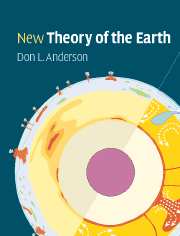Book contents
- Frontmatter
- Contents
- Preface and Philosophy
- Abbreviations and acronyms
- Part I Planetary perspective
- Part II Earth: the dynamic planet
- Part III Radial and lateral structure
- Part IV Sampling the Earth
- Chapter 12 Statistics and other damned lies
- Chapter 13 Making an Earth
- Chapter 14 Magmas: windows into the mantle
- Chapter 15 The hard rock cafe
- Chapter 16 Noble gas isotopes
- Chapter 17 The other isotopes
- Part V Mineral physics
- Part VI Origin and evolution of the layers and blobs
- Part VII Energetics
- References and notes
- Appendix
- Index
Chapter 15 - The hard rock cafe
Published online by Cambridge University Press: 05 June 2012
- Frontmatter
- Contents
- Preface and Philosophy
- Abbreviations and acronyms
- Part I Planetary perspective
- Part II Earth: the dynamic planet
- Part III Radial and lateral structure
- Part IV Sampling the Earth
- Chapter 12 Statistics and other damned lies
- Chapter 13 Making an Earth
- Chapter 14 Magmas: windows into the mantle
- Chapter 15 The hard rock cafe
- Chapter 16 Noble gas isotopes
- Chapter 17 The other isotopes
- Part V Mineral physics
- Part VI Origin and evolution of the layers and blobs
- Part VII Energetics
- References and notes
- Appendix
- Index
Summary
There are three kinds of rocks: Ingenious, Metaphoric, and Sedentary, named after the three kinds of geologists.
Anon.Ultramafic rocks
Ultramafic rocks (UMR) are composed chiefly of ferromagnesian minerals and have a low silicon content compared with the crust, mafic rocks and basalts. The term is often used interchangeably with ultrabasic; pyroxene-rich rocks are ultramafic but not ultrabasic because of their high SiO2 content. Peridotites, lherzolite, dunite and harzburgite are specific names applied to ultramafic rocks that are chiefly composed of olivine, orthopyroxene, clinopyroxene and an aluminous phase such as plagioclase, spinel or garnet. Ultramafic rocks are dense and mainly composed of refractory minerals with high seismic velocities. Basic rocks, such as basalts, become dense at high pressure (for example, eclogite) and can have properties comparable to the more refractory peridotites. Some eclogites overlap basalts in their bulk chemistry. The relationships between these rocks are shown in Figure 15.1.
Peridotites can represent
(1) The refractory residue left after basalt extraction.
(2) Cumulates formed by the crystallization of a magma.
(3) Primitive mantle that can yield basalts by partial melting.
(4) Cumulates or residues that have been intruded by basalt.
(5) High-pressure or high-temperature melts.
Peridotites contain more than 40% olivine. They are divided into fertile or infertile (or barren). Fertile peridotites can be viewed as having an appreciable basaltic component. The terms ‘enriched’ and ‘depleted’ are often used interchangeably with ‘fertile’ and ‘infertile’ but have trace-element and isotopic connotations that are often inconsistent with the major-element chemistry. Table 15.1 gives compositions for representative ultramafic rocks.
- Type
- Chapter
- Information
- New Theory of the Earth , pp. 189 - 197Publisher: Cambridge University PressPrint publication year: 2007



